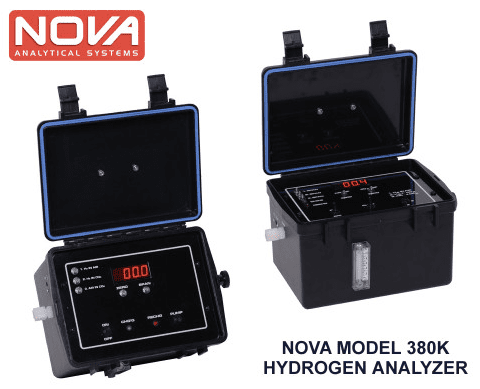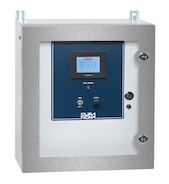Thermal Conductivity Analyzers
Thermal conductivity analyzers contain a sensing unit (transmitter), a control unit (receiver), and a power supply for analyzing a sample gas. These three components facilitate sensitive and reliable thermal conductivity analysis with quick turnaround times. This overview from Nova Analytical Systems will outline what gases thermal conductivity analyzers measure, how they work, and why they are beneficial for many industries and applications.
Gases Analyzed by Thermal Conductivity Analyzers
Thermal conductivity analyzers can be optimized to provide incredibly accurate analysis of hydrogen, hydrogen purity, or sulfur hexafluoride. In this section, we review how these different analyzers function and for what applications they are most often utilized.
Hydrogen (H2)
 Since it has the highest value of thermal conductivity amongst all gases, hydrogen is most commonly analyzed using thermal conductivity detection technology. Because it is not possible for another gas to have a higher value of thermal conductivity, this unique characteristic ensures a high rate of accuracy during analysis and makes determining whether hydrogen is present in a sample gas mixture a relatively simple task. When it comes to measuring hydrogen within a gas process gas mixture, however, thermal conductivity analyzers are most beneficial and efficient when combined with an electrochemical sensor or non-dispersive infrared (NDIR) analyzer to analyze the sample gas mixture’s other characteristics.
Since it has the highest value of thermal conductivity amongst all gases, hydrogen is most commonly analyzed using thermal conductivity detection technology. Because it is not possible for another gas to have a higher value of thermal conductivity, this unique characteristic ensures a high rate of accuracy during analysis and makes determining whether hydrogen is present in a sample gas mixture a relatively simple task. When it comes to measuring hydrogen within a gas process gas mixture, however, thermal conductivity analyzers are most beneficial and efficient when combined with an electrochemical sensor or non-dispersive infrared (NDIR) analyzer to analyze the sample gas mixture’s other characteristics.
Analyzing a sample gas mixture for hydrogen is useful for many industries. Hydrogen gas analysis can be used in hydrogen fuel cell production, manufacturing equipment, calcining furnaces, syngas, and many other industrial applications where hydrogen is commonly used.
Hydrogen Purity
 The purer a sample of hydrogen is, the better its thermal conductivity will be. Undiluted hydrogen is better at conducting heat than everyday air, making it essential for applications that require the removal of excess heat from an area. Even a small 1% change in purity can have an exponential effect on the efficiency of applications such as power generators.
The purer a sample of hydrogen is, the better its thermal conductivity will be. Undiluted hydrogen is better at conducting heat than everyday air, making it essential for applications that require the removal of excess heat from an area. Even a small 1% change in purity can have an exponential effect on the efficiency of applications such as power generators.
The explosiveness of hydrogen when combined with air presents a major challenge for using it as a cooling medium. If exposed to an ignition source, pure hydrogen may explode if it has been contaminated by even a small amount of standard air. Without contamination, however, high-purity hydrogen will not explode even under direct contact with an open flame. Hydrogen purity analyzers ensure that the hydrogen used in power generators is in an appropriately undiluted state.
Sulfur Hexafluoride (SF6)
 Featuring a long-lasting thermal conductivity cell that provides accurate and stable readings, sulfur hexafluoride analyzers are rugged, waterproof pieces of technology that alert the user to the amount of sulfur hexafluoride present in a sample. As a gas, sulfur hexafluoride is commonly used in blanketing applications such as those for power cable, switch gear, and magnesium production, making sulfur hexafluoride analyzers mandatory for these types of operations.
Featuring a long-lasting thermal conductivity cell that provides accurate and stable readings, sulfur hexafluoride analyzers are rugged, waterproof pieces of technology that alert the user to the amount of sulfur hexafluoride present in a sample. As a gas, sulfur hexafluoride is commonly used in blanketing applications such as those for power cable, switch gear, and magnesium production, making sulfur hexafluoride analyzers mandatory for these types of operations.
Operating Principle of Thermal Conductivity Sensors
The thermal conductivity sensors present in analyzers function by assessing the differences in thermal conductivities of a sample gas as compared to a reference gas. The analyzer possesses a reference chamber and a measuring chamber, each containing a thin platinum wire that facilitates analysis of the respective gases. As the thermal conductivity of the gases responds to temperature changes in the chamber, the concentrations of the gases react, allowing the analyzer to measure these changes and report them back as changes in electric resistance.
How Do Thermal Conductivity Sensors Work with Multi-Gas Analyzers?
Thermal conductivity analyzers often get combined with other types of analyzers to measure a sample more effectively. Because each gas in a sample contributes its own thermal conductivity value to the aggregate value of the sample, these gases (or the main gas being measured) must be isolated from the rest to ensure the most accurate reading possible. In most industries, gas samples will contain some variation of oxygen, carbon monoxide, carbon dioxide, methane, and hydrogen. By measuring the concentration of all gases in the sample including hydrogen, the error in the thermal conductivity measurement due to the presence of the other gases can be calculated and adjusted out of the hydrogen reading for optimal accuracy.
Thermal Conductivity Analyzers from Nova Analytical Systems
Thermal conductivity analyzers offer a means to analyze the thermal conductivity levels of a sample gas mixture quickly and accurately. At Nova Analytical Systems, we have more than 40 years of experience designing and manufacturing gas analysis systems, including thermal conductivity analyzers, for an assortment of industries. For more information on our available analyzers, please contact us or request a quote today.

